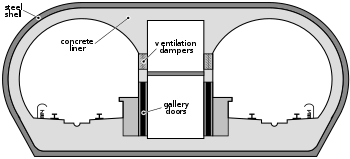Berkeley Hills Tunnel
|
East portal structure of the Berkeley Hills Tunnel | |
| Overview | |
|---|---|
| Line | |
| Location | Alameda County, California |
| Coordinates |
Oakland portal: 37°51′05″N 122°14′17″W / 37.85139°N 122.23806°W Orinda portal: 37°52′29″N 122°11′16″W / 37.87472°N 122.18778°W |
| System | Bay Area Rapid Transit |
| Crosses | Berkeley Hills, Hayward Fault |
| Start | Rockridge Station, Oakland |
| End | Orinda Station, Orinda |
| No. of stations | None |
| Operation | |
| Work begun | 1965 |
| Constructed | drill-and-blast |
| Opened | May 21, 1973 |
| Owner | San Francisco Bay Area Rapid Transit District |
| Operator | San Francisco Bay Area Rapid Transit District |
| Character | Rapid transit |
| Technical | |
| Line length | 3.1 mi (5.0 km) |
| No. of tracks | 2 |
| Track gauge |
5 ft 6 in (1,676 mm) (Indian gauge) |
| Electrified | Third rail, 1000 V DC |
| Tunnel clearance | 16.8 feet (5.1 m)[1] |
| Grade | 1.2% (2% max)[2] |
The Berkeley Hills Tunnel is a tunnel which carries Bay Area Rapid Transit's Antioch–SFO/Millbrae line through the Berkeley Hills between the Rockridge and Orinda stations.
Design
While the tracks run in the median of California State Route 24 on both sides of the tunnel, the Berkeley Hills Tunnel allows the tracks to take a straighter alignment offset to the north of the Caldecott Tunnel.
The tunnel bores through the Berkeley Hills east of Berkeley and Oakland a distance of 3.1 miles (5.0 km)[2] through a variety of rock strata, most of which are soft and porous. The earthquake-active Hayward Fault bisects the tunnel about 900 feet (270 m) inside the west portal (Oakland side). There are 2 bores, each 17.5 feet (5.3 m) in diameter,[2] spaced 50 feet (15 m) apart. Pedestrian cross-tunnels are spaced every 1,000 feet (300 m) for emergency evacuation in case of fire, etc. There is a ventilation structure at the east portal with roll-down doors that can close off the tunnel end to allow air to be sucked out or blown in.
Due to cumulative minor damage to the tunnel from fault creep, BART has initiated a study for repairs to the tunnel.[3]
Construction
Boring was completed in February 1967 after 465 work days. The tunnel was opened for revenue service in 1973.
Material removed in the construction of the tunnel was used as fill for a concurrent expansion of the Port of Oakland.[4]
Incidents
On December 4, 2013, a BART train suffered mechanical braking problems and made an emergency stop in the Berkeley Hills Tunnel near Rockridge station. Eleven people were treated for smoke inhalation.[5]
See also
References
- ↑ "Figure 12".
- 1 2 3 Rogers & Peck. "Engineering Geology of the Bay Area Rapid Transit (BART) System, 1964-75". Index of /~mly/www.geolith.com. Geolith Engineering. Retrieved 22 June 2017.
- ↑ "August Monthly Meeting: Caldecott BART Tunnel Creep Repair - SEAONC". www.seaonc.org.
- ↑ Berkeley Gazette, October 24, 1966, p.13
- ↑ Shields, Brian (December 4, 2013). "BART Brake Smoke Causes Injuries in Caldecott Tube". KRON4. Retrieved 2013-12-05.
